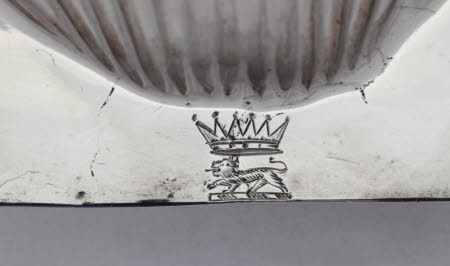Six scallop shells
Category
Silver
Date
c. 1756
Materials
Silver
Measurements
1.9 x 11.4 x 11.4 cm
Order this imageCollection
Ickworth, Suffolk
NT 852186
Summary
Six scallop shells, silver, probably Turin, circa 1756. The shell-shaped dishes with flat end grips are raised and have chased, fanning flutes. Heraldry: Each of the dishes is engraved on the end grip with the Hervey crest beneath an earl’s coronet. Hallmarks: None. Scratchweights: ‘N1 5=9’; ‘N2 4=8’; ‘N3 4=0’; ‘N4 3=7’; ‘N5 4=[2]’ (according to the 1811 plate list); ‘N6 4=0’.
Full description
Sets of silver scallop shells had been made since at least the Restoration and there are significant survivals from as early as 1675.[1] Many have additional, chased surface treatment to give an even more naturalistic appearance and the provision of winkle or other feet had become commonplace by the mid eighteenth century to stabilise them on the table. The Ickworth shells are, however, of the simplest form, without feet or surface treatment, and the style of engraving and of the scratchweights suggests they were made in Turin. The rendering of the Hervey crests and earl’s coronets is, to say the least, rudimentary, and is comparable to that on Boucheron’s sugar ladles (cat. 59). Scientific analysis has confirmed that the metal used was of sterling standard, the silver content being 94.3%.[2] Such shells were probably most often used for oyster recipes, which would have been cooked and served in them, as is still the case with natural shells in French cuisine today. An example is to be found in Elizabeth Moxon’s English housewifry, first published in 1741: ‘Take half a Dozen small Scallop Shells, lay in the bottom of every Shell a Lump of Butter, a few Bread-crumbs, and then your Oysters; lying over them again a few more Bread-crumbs, a little butter, and a little Pepper, so set them to crisp, either in the Oven or before the Fire, and serve them up. They are proper for either a side Dish or middle Dish.’[3] A similar recipe of 1723 specified the shells to be of silver [4] as did Vincent La Chapelle for his ‘Pigeons in Scollop Shells’. In that recipe, once the pigeons had been stewed with bacon, lemon ‘and a Glass of white Wine’, and ragout sauces had been prepared, the cook was instructed to: ‘Then take six Shells, there are some of Silver, which are very like the natural ones, in which you make a small Border of Paste [pastry] round it as neat as you can; rub it over with Egg, and let it be baked in the Oven; then order your Shells in the Dish. Take your Pigeons out of their Seasoning … put one of them into each Shell, and order the whole as neat as you can, and serve it up hot for Entry [entrée]; and let it be pleasing to the Eye.’[5] James Rothwell, Decorative Arts Curator May 2021 [Adapted from James Rothwell, Silver for Entertaining: The Ickworth Collection, London 2017, cat. 61, p. 147] Notes: [1] A set of ten by Samuel Hood, 1675, were sold at Christie’s 12 June 2002. [2] X-ray fluorescence (XRF) analysis carried out by the London Assay Office, March, 2015. [3] Elizabeth Moxon, English Housewifry, Leeds 1753, p. 115. [4] Cited in Philippa Glanville (ed.), Silver, London 1996, p. 43 [5] Vincent La Chapelle, The modern cook, 2nd edition, London 1736, vol. 1, p. 247.
Provenance
George Hervey, 2nd Earl of Bristol (1721-75); by descent to the 4th Marquess of Bristol (1863-1951); accepted by the Treasury in lieu of death duties in 1956 and transferred to the National Trust.
Credit line
Ickworth, the Bristol Collection (National Trust)




